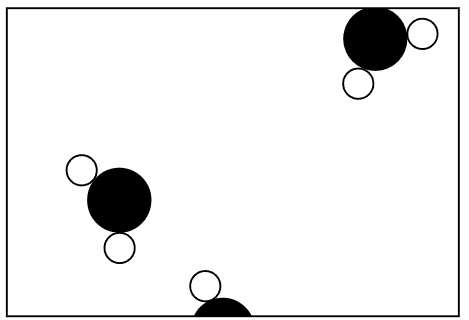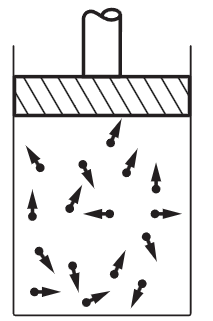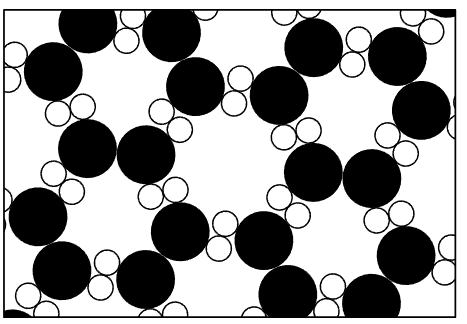If, in some cataclysm, all of scientific knowledge were to be destroyed, and only one sentence passed on to the next generations of creatures, what statement would contain the most information in the fewest words? I believe it is the atomic hypothesis (or the atomic fact, or whatever you wish to call it) that all things are made of atoms—little particles that move around in perpetual motion, attracting each other when they are a little distance apart, but repelling upon being squeezed into one another. In that one sentence, you will see, there is an enormous amount of information about the world, if just a little imagination and thinking are applied.

WATER MAGNIFIED ONE BILLION TIMES
Figure 1–1
To illustrate the power of the atomic idea, suppose that we have a drop of water a quarter of an inch on the side. If we look at it very closely, we see nothing but water—smooth, continuous water. Even if we magnify it with the best optical microscope available—roughly two thousand times—then the water drop will be roughly forty feet across, about as big as a large room, and if we looked rather closely, we would still see relatively smooth water—but here and there small football-shaped things swimming back and forth. Very interesting. These are paramecia. You may stop at this point and get so curious about the paramecia with their wiggling cilia and twisting bodies that you go no further, except perhaps to magnify the paramecia still more and see inside. This, of course, is a subject for biology, but for the present we pass on and look still more closely at the water material itself, magnifying it two thousand times again. Now the drop of water extends about fifteen miles across, and if we look very closely at it we see a kind of teeming, something which no longer has a smooth appearance—it looks something like a crowd at a football game as seen from a very great distance. In order to see what this teeming is about; we will magnify it another two hundred and fifty times and we will see something similar to what is shown in Fig. 1-1. This is a picture of water magnified a billion times, but idealized in several ways. In the first place, the particles are drawn in a simple manner with sharp edges, which is inaccurate. Secondly, for simplicity, they are sketched almost schematically in a two-dimensional arrangement, but of course they are moving around in three dimensions. Notice that there are two kinds of “blobs” or circles to represent the atoms of oxygen (black) and hydrogen (white), and that each oxygen has two hydrogens tied to it. (Each little group of an oxygen with its two hydrogens is called a molecule.) The picture is idealized further in that the real particles in nature are continually jiggling and bouncing, turning and twisting around one another. You will have to imagine this as a dynamic rather than a static picture. Another thing that cannot be illustrated in a drawing is the fact that the particles are “stuck together”—that they attract each other, this one pulled by that one, etc. The whole group is “glued together,” so to speak. On the other hand, the particles do not squeeze through each other. If you try to squeeze two of them too close together, they repel.
The atoms are 1 or 2×10−8 cm in radius. Now 10−8 cm is called an angstrom (just as another name), so we say they are 1 or 2 angstroms (Å) in radius. Another way to remember their size is this: if an apple is magnified to the size of the earth, then the atoms in the apple are approximately the size of the original apple.
Now imagine this great drop of water with all of these jiggling particles stuck together and tagging along with each other. The water keeps its volume; it does not fall apart, because of the attraction of the molecules for each other. If the drop is on a slope, where it can move from one place to another, the water will flow, but it does not just disappear—things do not just fly apart—because of the molecular attraction. Now the jiggling motion is what we represent as heat: when we increase the temperature, we increase the motion. If we heat the water, the jiggling increases and the volume between the atoms increases, and if the heating continues there comes a time when the pull between the molecules is not enough to hold them together and they do fly apart and become separated from one another. Of course, this is how we manufacture steam out of water—by increasing the temperature; the particles fly apart because of the increased motion.

STEAM
Figure 1–2
In Fig. 1-2 we have a picture of steam. This picture of steam fails in one respect: at ordinary atmospheric pressure there certainly would not be as many as three water molecules in this figure. Most squares this size would contain none—but we accidentally have two and a half or three in the picture (just so it would not be completely blank). Now in the case of steam we see the characteristic molecules more clearly than in the case of water. For simplicity, the molecules are drawn so that there is a 120º angle between the hydrogen atoms. In actual fact the angle is 105º3′105º3′, and the distance between the center of a hydrogen and the center of the oxygen is 0.957 Å, so we know this molecule very well.
Let us see what some of the properties of steam vapor or any other gas are. The molecules, being separated from one another, will bounce against the walls. Imagine a room with a number of tennis balls (a hundred or so) bouncing around in perpetual motion. When they bombard the wall, this pushes the wall away. (Of course, we would have to push the wall back.) This means that the gas exerts a jittery force which our coarse senses (not being ourselves magnified a billion times) feel only as an average push. In order to confine a gas, we must apply a pressure. Figure 1-3 shows a standard vessel for holding gases (used in all textbooks), a cylinder with a piston in it. Now, it makes no difference what the shapes of water molecules are, so for simplicity we shall draw them as tennis balls or little dots. These things are in perpetual motion in all directions. So many of them are hitting the top piston all the time that to keep it from being patiently knocked out of the tank by this continuous banging, we shall have to hold the piston down by a certain force, which we call the pressure (really, the pressure times the area is the force). Clearly, the force is proportional to the area, for if we increase the area but keep the number of molecules per cubic centimeter the same, we increase the number of collisions with the piston in the same proportion as the area was increased.

Figure 1–3
Now let us put twice as many molecules in this tank, so as to double the density, and let them have the same speed, i.e., the same temperature. Then, to a close approximation, the number of collisions will be doubled, and since each will be just as “energetic” as before, the pressure is proportional to the density. If we consider the true nature of the forces between the atoms, we would expect a slight decrease in pressure because of the attraction between the atoms, and a slight increase because of the finite volume they occupy. Nevertheless, to an excellent approximation, if the density is low enough that there are not many atoms, the pressure is proportional to the density.
We can also see something else: If we increase the temperature without changing the density of the gas, i.e., if we increase the speed of the atoms, what is going to happen to the pressure? Well, the atoms hit harder because they are moving faster, and in addition they hit more often, so the pressure increases. You see how simple the ideas of atomic theory are.
Let us consider another situation. Suppose that the piston moves inward, so that the atoms are slowly compressed into a smaller space. What happens when an atom hits the moving piston? Evidently it picks up speed from the collision. You can try it by bouncing a ping-pong ball from a forward-moving paddle, for example, and you will find that it comes off with more speed than that with which it struck. (Special example: if an atom happens to be standing still and the piston hits it, it will certainly move.) So, the atoms are “hotter” when they come away from the piston than they were before they struck it. Therefore, all the atoms which are in the vessel will have picked up speed. This means that when we compress a gas slowly, the temperature of the gas increases. So, under slow compression, a gas will increase in temperature, and under slow expansion it will decrease in temperature.

ICE
Figure 1–4
We now return to our drop of water and look in another direction. Suppose that we decrease the temperature of our drop of water. Suppose that the jiggling of the molecules of the atoms in the water is steadily decreasing. We know that there are forces of attraction between the atoms, so that after a while they will not be able to jiggle so well. What will happen at very low temperatures is indicated in Fig. 1–4: the molecules lock into a new pattern which is ice. This particular schematic diagram of ice is wrong because it is in two dimensions, but it is right qualitatively. The interesting point is that the material has a definite place for every atom, and you can easily appreciate that if somehow or other we were to hold all the atoms at one end of the drop in a certain arrangement, each atom in a certain place, then because of the structure of interconnections, which is rigid, the other end miles away (at our magnified scale) will have a definite location. So if we hold a needle of ice at one end, the other end resists our pushing it aside, unlike the case of water, in which the structure is broken down because of the increased jiggling so that the atoms all move around in different ways. The difference between solids and liquids is, then, that in a solid the atoms are arranged in some kind of an array, called a crystalline array, and they do not have a random position at long distances; the position of the atoms on one side of the crystal is determined by that of other atoms millions of atoms away on the other side of the crystal. Figure 1–4 is an invented arrangement for ice, and although it contains many of the correct features of ice, it is not the true arrangement. One of the correct features is that there is a part of the symmetry that is hexagonal. You can see that if we turn the picture around an axis by 60∘60∘, the picture returns to itself. So there is a symmetry in the ice which accounts for the six-sided appearance of snowflakes. Another thing we can see from Fig. 1-4 is why ice shrinks when it melts. The particular crystal pattern of ice shown here has many “holes” in it, as does the true ice structure. When the organization breaks down, these holes can be occupied by molecules. Most simple substances, with the exception of water and type metal, expand upon melting, because the atoms are closely packed in the solid crystal and upon melting need more room to jiggle around, but an open structure collapse, as in the case of water.
Now although ice has a “rigid” crystalline form, its temperature can change—ice has heat. If we wish, we can change the amount of heat. What is the heat in the case of ice? The atoms are not standing still. They are jiggling and vibrating. So even though there is a definite order to the crystal—a definite structure—all of the atoms are vibrating “in place.” As we increase the temperature, they vibrate with greater and greater amplitude, until they shake themselves out of place. We call this melting. As we decrease the temperature, the vibration decreases and decreases until, at absolute zero, there is a minimum amount of vibration that the atoms can have, but not zero. This minimum amount of motion that atoms can have is not enough to melt a substance, with one exception: helium. Helium merely decreases the atomic motions as much as it can, but even at absolute zero there is still enough motion to keep it from freezing. Helium, even at absolute zero, does not freeze, unless the pressure is made so great as to make the atoms squash together. If we increase the pressure, we can make it solidify.
 الاكثر قراءة في خواص المادة
الاكثر قراءة في خواص المادة
 اخر الاخبار
اخر الاخبار
اخبار العتبة العباسية المقدسة


